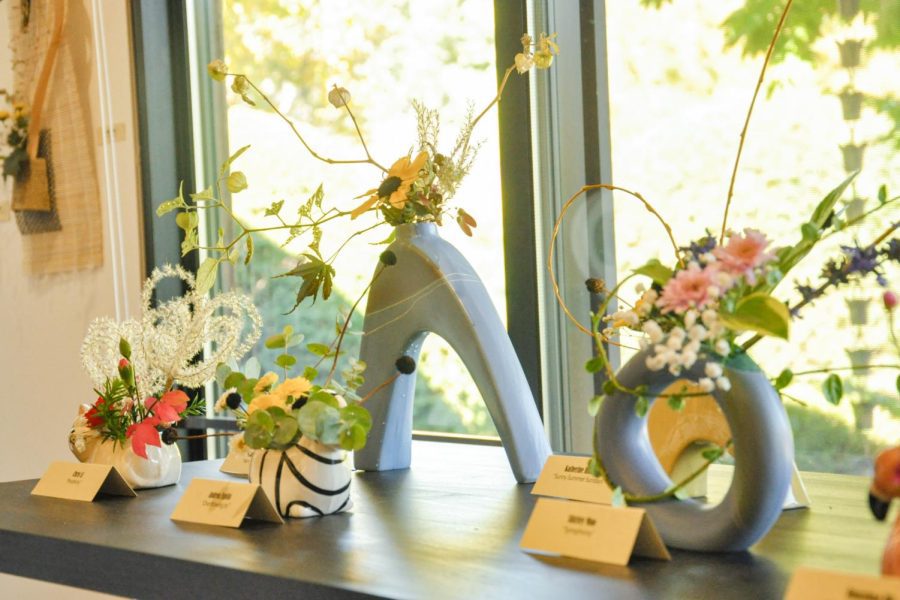Elegance, Repose and everything in between: Japan House hosts Ikebana Student Exhibition
A display of vases with arranged flowers is presented at the Japan House on Saturday. These pieces were created by students of ARTJ 199: Special Topics in Japanese Aesthetic Practices.
October 10, 2022
Rows of vivid wall hangings welcomed one into the quaint, cozy Japan House. The bright afternoon sun shone through the windows behind the mesmerizing Origami swans. Through the corridor, the main focus appeared: Ikebana, or Japanese flower arrangement.
On Saturday, the Japan House hosted an Ikebana Student Exhibition. Students of ARTJ 199: Special Topics in Japanese Aesthetic Practices taught by professor emeritus Kimiko Gunji put up a display of their final artwork at a free exhibition. In this half-semester course, 18 students from various majors mastered the art of Ikebana. The theme of the exhibition was Kokoro: heart, mind and spirit.
Jennifer Gunji-Ballsrud, director of the Japan House, encourages students to embrace the culture. She is Professor Gunji’s daughter and has been the director for 11 years.
“What these students accomplished in six weeks is phenomenal,” Gunji-Ballsrud said. “Students who have never touched art can now create masterpieces. They appreciate every line, every shape, even the container.”
Gunji-Ballsrud contrasted Ikebana to the Western flower arrangement.
Get The Daily Illini in your inbox!
“Western bouquets are gigantic and maximalist,” Gunji-Ballsrud said. “They are beautiful too, but Ikebana requires so much more thought. Western flower arrangement is often just in a typical glass container. But Ikebana also focuses on integrating the flowers with the container. One can enjoy all aspects of the process. It is not repetitive, but harmonious.”
In the main room, beautiful wall hangings of Ikebana adorned the walls. Tables full of vases with gorgeously arranged flowers showed the heart the students had put into every piece. More origami craftwork hung from the roof. Every piece had the text “Arigato No Kokoro” written, which translates to “thankful heart, mind and spirit.”
Chris Li, junior in Engineering, said this class helped him unwind from the stress of his academic commitments. His piece, “Positivity,” was in the form of a cat-shaped vase with precisely positioned pink and white flowers showing his passion for the art.
“I was an art student before I started college, and I enjoy applying those concepts to this class,” Li said. “Before we start a piece, we need to define our Kokoro — where we feel our heart is. It is then that such soulful pieces are born.”
Japanese artwork and goodies for sale sat on a wall in the main room. Japanese towels, ceramic utensil sets, tea sets and tea boxes were the main attraction. Smaller Kawaii-themed goodies like gum, collectible figurines and craft sets were also on display. The section was a bioscope into everything the Japan House has to offer to culture enthusiasts.
Rita Ni, freshman in FAA, was visiting the Japan House for the first time for this event. She said she was a little familiar with the Japanese culture before her visit but had never appreciated Ikebana before.
“This reflects traditional Japan,” Ni said. “The artwork is very aesthetic; simple, elegant, and very pleasing to look at.”
Ben Macke, senior in FAA, was also presenting Ikebana at the event. He said he harbors a deep love for Japanese culture, especially the tea ceremony.
“Chadō, or the tea ceremony, holds a special place in my heart since I started studying it last fall,” Macke said. “Students that are in stressful majors should check out the classes that Japan House offers. It is an awesome way to leave everything else and enjoy tranquility through the Japanese Zen philosophy.”
Such sentiments were echoed by many students studying at the Japan House. Li and Macke both said that classes at the Japan House help students take a break from the hustle they engage in every day.
Diane Liao, an education associate at the Japan House, said that working there has been a very enriching experience.
“I had the great fortune of being a student, then being an employee here and finally an instructor for the classes,” Liao said. “It’s wonderful; we are growing so much that we can now offer a minor in Japanese arts and aesthetics. It’s just so heartwarming to see that students are embracing cultural diversity with a willingness to learn.”








